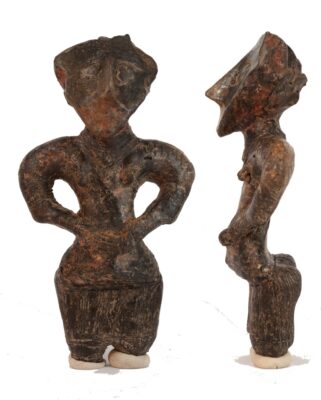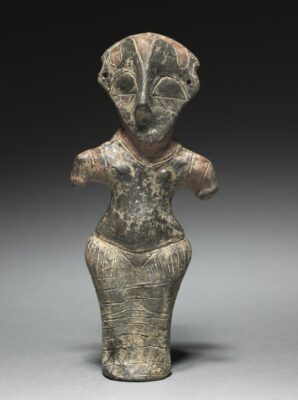A remarkable discovery in southern Serbia has brought to light a 7500-year-old Neolithic figurine, offering a rare look into the fashion and artistry of ancient European civilizations. This figurine, found in the Plocnik archaeological site near Prokuplje, provides invaluable insights into the Vinca culture, one of Europe’s earliest and most sophisticated prehistoric societies. Follow archeology.dulichvn.net to learn more about mysterious artifacts.

The Discovery of the 7500-Year-Old Figurine
A Glimpse into Prehistoric Europe: Fashion and Culture of the Vinca People
The remarkable 7500-year-old figurine, discovered during recent excavations at the Plocnik archaeological site in southern Serbia, offers an invaluable glimpse into the lives of prehistoric Europeans. Dating back to approximately 5500 BC, this intricately carved stone figurine portrays a girl adorned in a short skirt and an elaborate, ornate top, providing a fascinating look at the fashion choices of early European societies. This discovery not only sheds light on the clothing styles of the time but also hints at the cultural and artistic values of the Vinca civilization.
The Significance of the Plocnik Archaeological Site
Nestled near the town of Prokuplje in southern Serbia, the Plocnik site plays a crucial role in our understanding of the Vinca culture, one of Europe’s most influential and early prehistoric civilizations. Flourishing between 5700 and 4500 BC, the Vinca people are recognized for their advanced society, leaving behind evidence of their sophisticated settlements, early written symbols, and finely crafted artifacts. The figurine uncovered at Plocnik is an exceptional testament to the skill and artistry of the Vinca artisans. Its preservation offers unique insight into the aesthetics, daily life, and rituals of this ancient civilization, showcasing the intricate craftsmanship that characterized their cultural legacy.
The Vinca Civilization: Europe’s Ancient Metropolis of Art and Innovation
Archaeological evidence suggests that the Vinca civilization was one of the largest and most advanced cultures in prehistoric Europe, often considered a thriving metropolis of its time. The Vinca people were highly skilled in various crafts, including pottery, metallurgy, and stone carving, with evidence pointing to their involvement in early urban planning and organized social structures.
This recent discovery of the figurine further underscores the Vinca people’s deep appreciation for art, fashion, and symbolism, indicating that these elements were integral to their society. The figurine’s detailed design—combined with the fashion choices it depicts—offers a glimpse into the artistic and cultural sophistication that marked the Vinca civilization as a leading force in Europe’s prehistoric history.

The Vinca Culture and Its Influence on Europe
A Highly Developed Civilization: The Sophistication of the Vinca Culture
The Vinca culture stands out as one of the most advanced and influential civilizations in prehistoric Europe. Flourishing between 5700 and 4500 BC, the Vinca people demonstrated remarkable innovation in various aspects of their society. Known for their well-planned, organized settlements, they laid the foundation for early urbanization, complete with homes, communal spaces, and evidence of sophisticated trade networks. Furthermore, the Vinca people were pioneers in early forms of writing, leaving behind symbols and markings that suggest a rudimentary system of communication.
Their expertise in architecture and construction, along with highly developed craftsmanship in pottery, metallurgy, and sculpture, marks them as one of Europe’s leading prehistoric cultures. The figurine unearthed at the Plocnik site is a testament to their artistic prowess, highlighting their ability to create detailed, symbolic art that resonates even thousands of years later.
Fashion and Art in Ancient Serbia: A Glimpse into Vinca Style
The stone-carved figurine offers a fascinating look into the fashion trends of the Vinca culture. The depiction of a young girl wearing a short skirt and an elaborate, ornate top provides key insights into how the people of Vinca may have dressed in daily life. Fashion was not just about practicality in Vinca society; it was deeply intertwined with cultural identity, personal expression, and social status.
Archaeologists believe that clothing and jewelry played a significant role in the Vinca culture, with fashion serving as both a form of self-expression and a way to demonstrate wealth, social rank, and cultural affiliation. The figurine’s carefully crafted details suggest that the Vinca people had a sophisticated sense of style, with clothing and adornment reflecting the importance of beauty and aesthetics in their daily lives.
Craftsmanship and Symbolism in Vinca Art: Deeper Meanings Embedded in Stone
Beyond its aesthetic appeal, the figurine also serves as a powerful symbol of the Vinca people’s artistic vision and cultural beliefs. Made from local stone, the figurine exemplifies the high level of craftsmanship that defined the Vinca culture. Its stylized features, including exaggerated facial expressions and simplified forms, show the Vinca people’s approach to human representation, which was less focused on realism and more on symbolism.
The use of exaggerated features might suggest that the figurine had a ritualistic or spiritual purpose, perhaps representing a deity, ancestor, or other revered figure in their society. This figurine’s detailed carving demonstrates the Vinca’s advanced understanding of symbolism and their ability to convey complex cultural narratives through art, further solidifying their legacy as one of Europe’s most sophisticated prehistoric cultures.

See more: The Gundestrup Cauldron: A Marvel of Celtic Art and Culture
The 5500 BC Figurine: A Remarkable Artifact
The Intricate Details of the Figurine: Mastery in Stone-Carving
This stone-carved figurine, dating back to 5500 BC, stands as a remarkable example of the advanced craftsmanship achieved by the Vinca people. The intricate details etched into the stone highlight the exceptional skill and precision of Vinca artisans. Features such as the exaggerated facial expressions and carefully shaped body structure demonstrate their deep understanding of form and texture.
The figurine’s craftsmanship is particularly impressive given the tools available during that time, underscoring the Vinca culture’s ability to create complex and sophisticated works of art. The finely executed carving of this figurine not only reveals the technical mastery of the Vinca people but also their artistic vision, which was centuries ahead of its time.
Symbolism and Representation in Early Art: A Spiritual and Cultural Message
The figurine is believed to represent a humanoid figure, although its stylized features and proportions suggest that it was not intended to be a realistic portrait. Instead, the exaggerated facial expressions and simplified body structure likely carried symbolic or spiritual meaning for the Vinca people. In early European art, such stylized depictions were often used to convey deeper cultural or religious messages, such as representations of deities, spirits, or revered ancestors.
The figurine’s features may have been intentionally exaggerated to invoke a sense of otherworldliness or to symbolize the connection between humans and supernatural forces. This focus on symbolism through art points to the Vinca culture’s sophisticated understanding of human form and its ability to use art as a tool for expressing spiritual beliefs and cultural narratives.
Preservation of Prehistoric Art: A Window into Vinca Civilization
The preservation of this ancient figurine for over 7,000 years offers an invaluable window into the culture, beliefs, and daily life of the Vinca civilization. The survival of such artifacts provides us with tangible connections to a society that once thrived in prehistoric Europe.
As one of the few surviving examples of Vinca art, this figurine acts as a key to understanding the artistic practices, symbolic beliefs, and social structures of the time. Its remarkable state of preservation allows modern-day researchers and archaeologists to piece together the history of a culture that was both highly advanced and deeply spiritual. This figurine is not only an exquisite work of art but also a testament to the lasting legacy of the Vinca people, whose contributions to early European civilization continue to inspire awe and admiration.

Conclusion: A Window into the Past
The discovery of this 7500-year-old Neolithic figurine from the Plocnik archaeological site offers a fascinating glimpse into the world of the Vinca culture. With its detailed craftsmanship and symbolic representation, the figurine highlights the artistic and fashion sense of early European societies. This discovery not only deepens our understanding of prehistoric Europe but also emphasizes the cultural sophistication of the Vinca civilization, offering a window into a world long gone but not forgotten.


CÁC TIN KHÁC
Mary Walton: The Forgotten Inventor Who Helped Clean Up America’s Cities
Tomb of Queen Nefertari in the Valley of the Queens, Egypt
Discover the Hypostyle Hall of the Temple of Hathor at Dendera
Venus de Losange: Unveiling the Mystery of a 20,000-Year-Old Paleolithic Icon